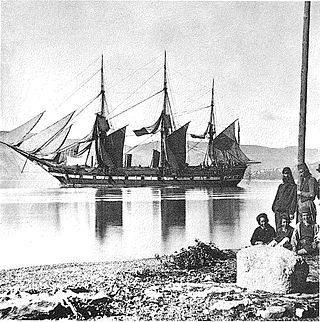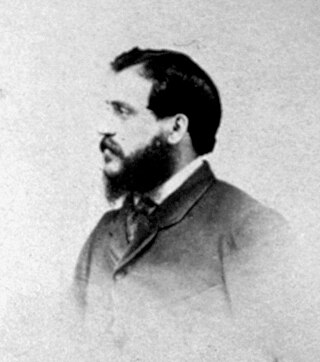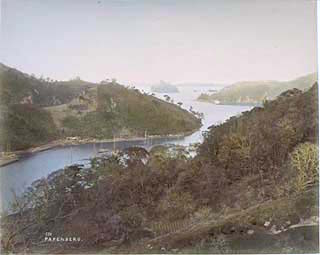Felice A. Beato and Felice Antonio Beato are collective signatures used by the brothers Felice Beato and Antonio Beato, who were both pioneering photographers in the 19th century. They were noted for their depictions of everyday life in Orient.

War photography involves photographing armed conflict and its effects on people and places. Photographers who participate in this genre may find themselves placed in harm's way, and are sometimes killed trying to get their pictures out of the war arena.

James Robertson (1813–1888) was an English gem and coin engraver who worked in the Mediterranean region, and who became a pioneering photographer working in the Crimea and possibly India. He is noted for his Orientalist photographs and for being one of the first war photographers.
Photography in China dates back to the mid-19th century with the arrival of European photographers in Macao. In the 1850s, western photographers set up studios in the coastal port cities, but soon their Chinese assistants and local competition spread to all regions.

Kusakabe Kimbei was a Japanese photographer. He usually went by his given name, Kimbei, because his clientele, mostly non-Japanese-speaking foreign residents and visitors, found it easier to pronounce than his family name.

Antonio Beato, also known as Antoine Beato, was an Italian-British photographer. He is noted for his genre works, portraits, views of the architecture and landscapes of Egypt and other locations in the Mediterranean region. He was the younger brother of photographer Felice Beato (1832–1909), with whom he sometimes worked. Antonio and his brother were part of a small group of commercial photographers who were the first to produce images of the Orient on a large scale.

Hand-colouring refers to any method of manually adding colour to a monochrome photograph, generally either to heighten the realism of the image or for artistic purposes. Hand-colouring is also known as hand painting or overpainting.

Wilhelm Joseph Burger was an Austrian photographer and painter, based in Vienna. Around the 1870s, he traveled to Thailand and Japan, as well as the Arctic, where he took photographs that have become historical documents and are kept in international archives.

Adolfo Farsari was an Italian photographer based in Yokohama, Japan. His studio, the last notable foreign-owned studio in Japan, was one of the country's largest and most prolific commercial photographic firms. Largely due to Farsari's exacting technical standards and his entrepreneurial abilities, it had a significant influence on the development of photography in Japan.

Felice Beato, also known as Felix Beato, was an Italian–British photographer. He was one of the first people to take photographs in East Asia and one of the first war photographers. He is noted for his genre works, portraits, and views and panoramas of the architecture and landscapes of Asia and the Mediterranean region. Beato's travels gave him the opportunity to create images of countries, people, and events that were unfamiliar and remote to most people in Europe and North America. His work provides images of such events as the Indian Rebellion of 1857 and the Second Opium War, and represents the first substantial body of photojournalism. He influenced other photographers, and his influence in Japan, where he taught and worked with numerous other photographers and artists, was particularly deep and lasting.

Pierre Joseph Rossier was a pioneering Swiss photographer whose albumen photographs, which include stereographs and cartes-de-visite, comprise portraits, cityscapes, and landscapes. He was commissioned by the London firm of Negretti and Zambra to travel to Asia and document the progress of the Anglo-French troops in the Second Opium War and, although he failed to join that military expedition, he remained in Asia for several years, producing the first commercial photographs of China, the Philippines, Japan and Siam. He was the first professional photographer in Japan, where he trained Ueno Hikoma, Maeda Genzō, Horie Kuwajirō, as well as lesser known members of the first generation of Japanese photographers. In Switzerland he established photographic studios in Fribourg and Einsiedeln, and he also produced images elsewhere in the country. Rossier is an important figure in the early history of photography not only because of his own images, but also because of the critical impact of his teaching in the early days of Japanese photography.

Baron Raimund von Stillfried, also known as Baron Raimund von Stillfried-Rathenitz, was an Austrian military officer and early professional photographer in Japan. His historical photographs of Japan following the end of the Tokugawa shogunate in the 1870s have been appreciated for their documentary and artistic value and collected in international archives.
Tokutarō Watanabe was the owner of the A. Farsari & Co. photographic studio. Watanabe initially was the firm's chief operator under the ownership by Adolfo Farsari and then Tonokura Tsunetarō. Following the departure of Tonokura in 1904, Watanabe became the new owner, only to be succeeded by the firm's former secretary Fukagawa Itomaro. A. Farsari & Co. was based in Yokohama, Japan.

Hugues Krafft was a photographer born in Paris. He travelled around the world, and visited Japan in 1882–1883. He left numerous quality photographs of the period.

Shimooka Renjō was a Japanese photographer and was one of the first professional photographers in Japan. He opened the first commercial photography studio in Yokohama, and in Japan he is widely considered the father of Japanese photography.
Suzuki Shin'ichi was the younger of two Japanese photographers to bear that name.
The history of photography in Japan begins in the 19th century and has continued to be a prominent art form into the present era.
Philip Adolphe Klier, also known as Philip Klier, was a German photographer, who arrived in Burma as a young man around 1865 and spent the rest of his life there. Mainly working as self-trained photographer and businessman, Klier took hundreds of photographs at the end of the 19th century during the British colonial period in Burma. His photographs, taken both in his studio as well as on location, were mainly sold as picture postcards for foreign visitors. They have also been published in several books and collected in public archives. Among a small number of other photographers, Klier is considered as one of the earliest professional photographers in the history of today's Myanmar.

Thomas Child (1841–1898) was an English photographer and engineer best known for his pioneering photography work in China. Child produced a large body of photographs during his time in Beijing in the 1870s and 1880s, a time when virtually no other photographers operated in the city. During the two decades he spent in China, Child compiled the earliest comprehensive photographic catalogue of the customs, architecture, and people of late Qing dynasty Beijing. A keen photographer of architecture, some of Child's images are among the earliest and the only known photographic records of their architectural subjects.

Photography in India refers to both historical as well as to contemporary photographs taken in modern-day India.














